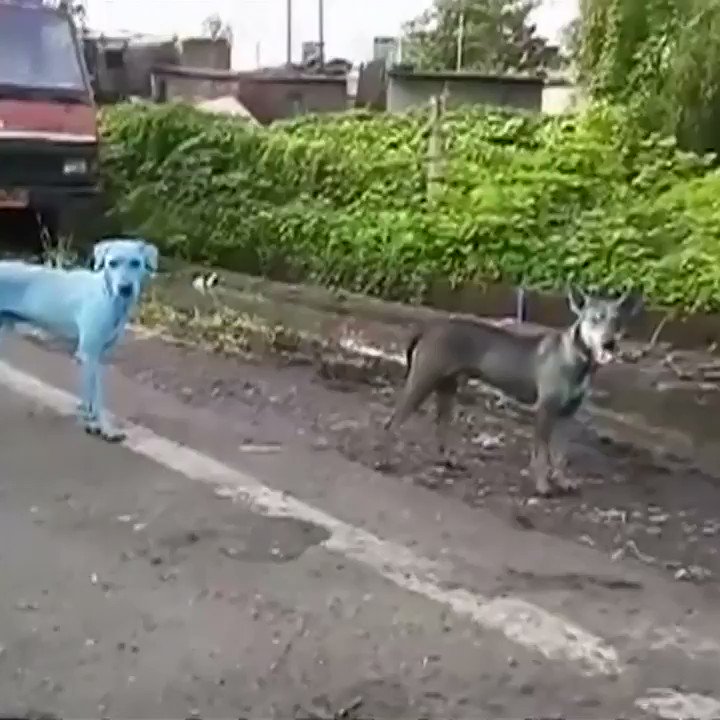It's A Dog's Life : India
"India is pretty unique."
"Maybe it's a karmic sense, this idea that the dog could be you, and if you don't watch out in life it could be you again."
"Or, maybe it's just that the poor have greater compassion because they can relate to other individuals who are having a hard time trying to survive."
Ingrid Newkirk, co-founder, People for the Ethical Treatment of Animals
"It comes down to tolerance. We've lived under Moghul rule, under British rule. It's crowded here, it's diverse, and to survive, you need to be tolerant."
"The more tolerant you are, the more compassion you have."
Niharika Kishan Gandhi, Mumbai, India
 |
| Local residents spotted the blue dogs roaming the streets in an industrial neighbourhood of Mumbai, India. (Arati Chauhan/Facebook) |
India must surely be among the most unique of nations, having enshrined in its very constitution (reflecting Hindu values) respect for animals. A passage within enjoins people of India to "have compassion for living creatures", which certainly goes a long way to explaining why cows are considered to be sacred, monkeys which can be a real nuisance are tolerated everywhere, and no real effort is made to secure storage of grain from predation by rats; everything, it seems, has a right to exist and to do so unharmed by the intention to see their presence as anything but normal.
The Supreme Court of India ordered Kerala state to see that vigilante action against the presence of stray dogs, seen as a threat resulting from deadly rabies proliferating, to cease and desist when strays were being hunted methodically to remove that threat. That presented as an anomaly in India where dogs are generally viewed as "community dogs", not strays. And as part of the community they are more often cared for as strays, to ensure they have enough to eat. Even the indigent poor with scarcely enough to eat themselves will feed strays.
 |
| A girl tries to protect her food from a stray dog in Mumbai on Oct. 3, 2005. Millions of strays roam India's growing urban centres, causing headaches for officials. (ADEEL HALIM / REUTERS FILE PHOTO) |
There is a Bollywood actress who sees that vessels of freshly-prepared chicken and rice are set out each morning to feed neighbourhood dogs, while another woman makes the effort in her own way, driving about in her outfitted Honda to deliver meals to over one hundred dogs, and for good measure sprinkling those meals with seasonal spices; where turmeric is considered appropriate for the monsoon season to help boost canine immunity.
In India it is illegal to destroy healthy strays, leading to the presence of millions of dogs, an estimated 30 million right across the country. Typically, Indian dogs have a large and lean/muscular profile. Roughly two feet in height, with short-hair coats, long tails with a tendency to curl upward. They are descended from a venerable dog breed similar to and likely related to the Australian dingo dog. They roam about in packs through parks and can be seen around restaurants awaiting scraps.
Commuters inside railway stations are accustomed to seeing dogs sprawl in those environs on their stomachs, and they take care to leap over them on their way to the trains. That the dogs are generally cared for by a population that accepts them as they are says much of the philosophy of life in a country whose vast population runs the gamut from the middle class to the teeming millions who live hardscrabble lives of penury.
India is also known as a textile-industry country, a condition which gave rise recently to dogs in Mumbai being seen with a blue tint on their coats. Resulting when a dye company released colour chemicals into a drainage ditch flowing into a river running through Mumbai where dogs often play. The colouring meant for clothing staining the dogs' hair soon washed off by the following monsoon rains. Until that happened, however, the community was concerned to help the dogs living in that heavily industrialized part of Mumbai.
Where large plants crowd the landscape, factories stretching as far as the eye can see with smokestacks spilling effluent everywhere, and a stink of their products stifling the atmosphere with a pervasive stench of rotten eggs characteristic of sulphur, the devil's stink. The area, Taloja, teems with dogs whom factory workers and villagers alike feed. They will go to the extent of acquiring shampoo to wash the the dogs that roam the streets freely.
 |
| Still from video news.com |
When the blue dye was first noticed on dogs, concerned workers contacted a neighbourhood human-rights activist who in turn contacted an animal-rights advocate who then called a veterinarian clinic nearby which rushed an ambulance to the scene. Soon afterward another incident with a dog occurred close to a factory where villagers waded into a ditch contaminated with nitric acid to rescue a trapped dog. The animal hospital named the rescued dog Babu and now cares for the dog who was blinded.
Charities dedicated to dogs, one named the Welfare of Stray Dogs, take to cruising about the city treating ill dogs and delivering healthy dogs to animal hospitals to be vaccinated and sterilized. Then, as required by law, the dogs are taken right back to the neighbourhood where they had originally been taken from. The government's plan is to reduce the population bit by bit through sterilization, a system thoroughly approved by animal welfare experts.
Sterilization also alters the behaviour of the dogs, which then have a tendency to be relaxed and friendlier, a condition that makes them even more attractive to the people among whom they live.

0 Comments:
Post a Comment
<< Home